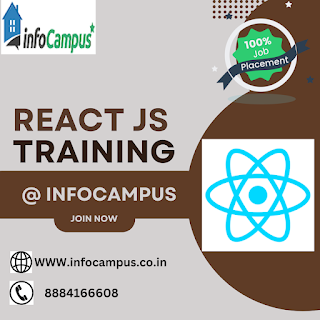In the ever-evolving world of web development, staying
relevant means keeping up with the latest technologies that shape how modern
applications are built. Among these technologies, React JS has emerged
as a game-changer, powering everything from simple websites to complex
enterprise-grade applications.
If you’re considering a career in front-end development or
looking to upgrade your skills, React
JS training at Infocampus can be your gateway to exciting job
opportunities and professional growth.
🌐 Understanding React JS:
More Than Just a Library
At its core, React JS is an open-source JavaScript
library developed by Facebook, used for building fast, interactive user
interfaces. Unlike traditional JavaScript or jQuery-based development, React
brings a whole new level of efficiency, maintainability, and scalability to
front-end development.
Its component-based structure allows developers to build
encapsulated UI components that manage their own state, and then compose them
to make complex user interfaces. It’s ideal for creating Single Page
Applications (SPAs), where user interaction is seamless, fast, and dynamic.
💡 Why React JS is Crucial
in Today’s Development Ecosystem
Let’s dive into the key reasons why mastering React JS has
become essential in the development industry.
1. 📈 Massive Industry Demand
React JS continues to dominate the front-end job market.
Major tech giants such as Facebook,
Instagram, Netflix, Airbnb, and WhatsApp use React JS to power their
web interfaces. This widespread adoption has led to an increased demand for
React developers, and the trend shows no sign of slowing down.
Recruiters are consistently on the lookout for professionals
skilled in React, and having formal training significantly improves your
chances of landing top-tier roles.
2. 🧱 Component-Based
Development
React promotes a modular approach to building UIs. With its component-based
architecture, developers can break down the UI into smaller parts, each
responsible for rendering a specific section. This makes code easier to manage,
debug, and scale.
Training in React teaches you how to create reusable
components that make your codebase cleaner and more efficient.
3. ⚡ Improved Performance with
Virtual DOM
One of the standout features of React JS is the Virtual
DOM. Instead of reloading the entire page, React updates only the parts
of the DOM that have changed. This optimization drastically enhances
performance and offers users a smoother, faster experience.
Understanding the inner workings of the Virtual DOM is a key
part of our training at Infocampus, ensuring you’re not just coding, but
building high-performance applications.
4. 🌐 SEO-Friendliness
Although JavaScript frameworks have traditionally been
considered less SEO-friendly, React
JS overcomes this limitation. With tools like Next.js and server-side
rendering (SSR), React-based applications can now rank effectively on search
engines. This is a crucial skill for developers working on commercial or
content-driven websites.
5. 🧑💻 Versatility
and Community Support
React has one of the largest developer communities, which
means extensive documentation, libraries, tutorials, and support. Whether it’s
integrating with Redux for state management or using frameworks like React
Native to build mobile apps, the possibilities with React are virtually
endless.
With this vibrant ecosystem, React developers can stay up to
date and continuously grow their skill sets.
🎓 Why Choose Infocampus
for React JS Training?
Infocampus, located in Bangalore – India’s tech capital –
offers a structured, hands-on, and career-oriented React JS training program.
Here’s why it’s the ideal place for beginners and experienced professionals
alike:
✅ Industry-Experienced Trainers
Our instructors are working professionals with
real-world React development experience. They don’t just teach theory – they
share practical knowledge, best practices, and insights that you won’t find in
typical online tutorials.
✅ Project-Based Learning
At Infocampus, we focus on learning by doing. From
day one, students work on live projects, simulating real industry environments.
By the end of the course, you’ll have a solid portfolio of React projects to
showcase in job interviews.
✅ Job-Oriented Curriculum
Our curriculum is designed with industry requirements in
mind. Whether it’s ES6+ features, functional components with hooks, routing, or
Redux for state management, we cover it all. We also provide training in
tools like Git, VS Code, and browser developer tools – everything a developer
needs in the modern workplace.
✅ 100% Placement Assistance
Infocampus has an excellent placement
track record. We provide full support for resume building, mock
interviews, and direct placement opportunities with our hiring partners in
Bangalore and across India.
✅ Flexible Learning Options
We offer both weekday and weekend batches, with
online and offline options, so that working professionals and students alike
can fit training into their schedules.
🏁 What Will You Learn in
Our React JS Course?
Here’s a glimpse of our comprehensive syllabus:
- HTML5,
CSS3, JavaScript ES6+
- Introduction
to React and JSX
- Components,
Props, and State
- Lifecycle
Methods and Hooks (useState, useEffect, useContext)
- React
Router DOM
- Redux
– State Management
- Fetching
data using APIs (REST)
- Form
handling and validation
- Real-time
mini and major projects
- Deployment
using Netlify or Vercel
- Git
& GitHub basics
Learn to build powerful and dynamic web applications with
our hands-on React JS training in Bangalore. At Infocampus, we
offer expert-led classes, real-time projects, and 100% placement support to
help you launch your front-end development career. Join today and become a
skilled React developer! For
more details Call: 8884166608 or 9740557058
Visit: https://infocampus.co.in/reactjs-training-in-marathahalli-bangalore.html
